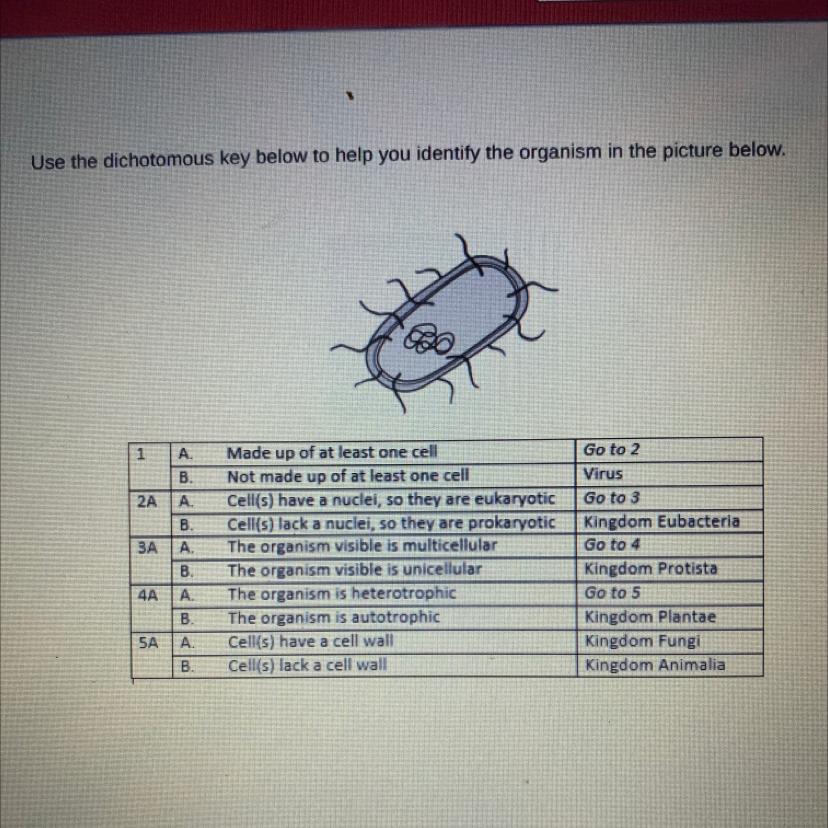How would you classify this organism based on the dichotomous key?
Select one:
A. Kingdom Plantae
B. Viruses
C. Kingdom Eubacteria
D. Kingdom Protista

Answers
Answer:
Explanation:
3a b is your answer
Related Questions
PLEASE HELP I NEED THIS TO PASS
Some organisms have a large geographic range. For example, the Norway rat lives on every continent except Antarctica A population of Norway rats is the number of rats in one particular area. Do you think it's scientifically possible for a population of Norway rats in North America to carry different genetic mutations than a population of Norway rats in Africa? Do you think it's possible that they carry some of the same mutations? What types of information can scientists learn by studying the genomes of these two populations of rats?
Answers
Green anoles were forced out of their established habitat of trees, plants, walls and fences by invasive brown anoles. The green anoles then had to find new habitats in wetlands and tree crowns. This example illustrates the concepts of:
Answers
Answer:
both competition and realized niche
Explanation:
how do plant tissue systems work together to maintain homeostasis
Answers
Analyze the punnett square R represents round seeds r represents wrinkled seeds
ratio of phenotypes:
ratio of genotypes
percent of offspring with round seeds:
percent of offspring with wrinkled seeds:
I need awner like a reason not a choice question
Answers
Note about the question:
You will find the Punnett square in the attached files
Answer:
ratio of phenotypes ⇒ 3:1 ratio of genotypes ⇒ 1:2:1 percent of offspring with round seeds ⇒ 75% percent of offspring with wrinkled seeds ⇒ 25%Explanation:
Due to technical problems, you will find the complete explanation in the attached files
A fossil contains 1/16 of the carbon -14 it began with. How old is the fossil?
Answers
Answer:
1/30
................
Which Cell Parts are ONLY in Plant cells?
Answers
Answer:
Cell Wall, Choroplast.
Explanation:
Identify the 2 main types of cetaceans and explain how they are classified.
Answers
The Mysticetes (baleen whales); and the Odontocetes (toothed whales). Baleen whales are also called mysticetes, which means “mustached whale”.
What is a nerve impulse?
Answers
Answer:
A signal transmitted along a nerve fiber. It consists of a wave of electrical depolarization that reverses the potential difference across the nerve cell membranes.
Explanation:
Answer:a signal transmitted along a nerve fiber. It consists of a wave of electrical depolarization that reverses the potential difference across the nerve cell membranes.
Explanation:
Of the terrestrial planets, Earth and Venus are
Which phrase best completes the sentence?
O about the same size
O different in density
O similar to gas planets
O very different in size
Answers
Answer:
A. About the same size
Explanation:
Venus is often named as Earth's twin because both worlds share a similar size, surface composition and have an atmosphere with a complex weather system. Both planets have almost the same size and density.
Hope this helps!
Earth and Venus are about the same size. So, the correct option is (A).
What is Earth?Earth is the third planet from the Sun and the only celestial object known to harbor life. Only Earth maintains liquid surface water in the Solar System. About 71% of Earth's surface is made up of ocean, which dwarfs Earth's polar ice caps, lakes, and rivers.
Earth consists of land, air, water and life where land consists of mountains, valleys and flat areas and air is composed of various gases, mainly nitrogen and oxygen. Water includes oceans, lakes, rivers, streams, rain, snow, and ice.
Venus is known as our sister planet because of the similarity in size, mass, density, and volume that both planets are believed to share a common origin at the same time from a condensed nebula about 4.5 billion years ago.
Thus, Earth and Venus are about the same size. So, the correct option is (A).
Learn more about Earth, here:
https://brainly.com/question/12041467
#SPJ6